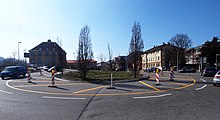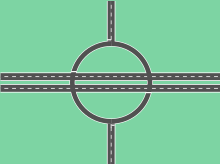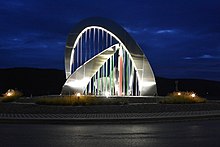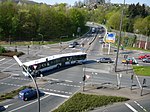Roundabout
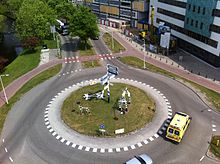
A roundabout or traffic roundabout (also known as roundabout (KVP), colloquially in parts of Germany, in Austria and in Switzerland, roundabout or plate , in South Tyrol called roundabout) is a hub in road traffic . It consists of the circular roadway and a center island . Like a one-way street, the circular lane is only to be driven in one direction; in right- hand traffic this is counter- clockwise (left-turning) and in left-hand traffic it is clockwise (right-turning).
history
The first roundabouts existed at the end of the 19th and the beginning of the 20th century. A roundabout was set up in New York in 1904 at Columbus Circle (by William Phelps Eno ) and in 1907 in Paris around the Arc de Triomphe (at the suggestion of Eugène Hénard ). The Görlitzer Brautwiesenplatz , built around 1899, is older, however , and is therefore probably the first roundabout.
In Germany, roundabouts were initially commonplace in the post-war period. However , the Federal Republic of Germany did not want to join the regulation contained in the Vienna Convention on Road Traffic of 1968 that the right-before-left rule generally applies in roundabouts with signs corresponding to today's sign 215 . The traffic sign roundabout was therefore removed from the road traffic regulations (StVO) with the traffic law reform of 1969 . To counter the risk of self-blockade with stronger traffic, instead, the traffic in the circle was way signs the right of way granted. The driveways were also provided with the give way sign . In the GDR, the sign became invalid with the 1977 road traffic regulations (its validity expired after January 15, 1978).
![]()
![]()
Due to misunderstandings in the calculation bases, roundabouts were increasingly forgotten. In the years that followed, roundabouts were often converted into intersections with traffic lights .
In other European countries, for example France, Great Britain and Spain, roundabouts continued to be built. Especially in France, which has 20,000 roundabouts (ronds-points, giratoires) and half of all roundabouts around the world, these are often used to regulate traffic. In 1984 the controversial right-before-left rule was repealed in France .
In 1994 the "roundabout" was included in the Swiss signaling ordinance .
Since the beginning of the 1990s, roundabouts have also experienced a renaissance in Germany. In 1995 and 1998 the Federal Ministry of Transport introduced regulations for the construction of roundabouts on federal roads outside built-up areas.
In Germany, with the amendment to the StVO on December 11, 2000, Section 9a was newly included in the StVO, which regulates behavior in roundabouts and ![]() defines the roundabout sign (sign 215 ). The regulation of § 9a StVO was incorporated into § 8 para. 1a StVO ngF with the amendment to the road traffic law of August 5, 2009 ( Federal Law Gazette I p. 2631, 2632 ) . The ban on driving over the central island and stopping in a circle have now been added to the signs (Annex 2 No. 8, 68 to Section 41 (1) of the Road Traffic Act) with effect from September 1, 2009.
defines the roundabout sign (sign 215 ). The regulation of § 9a StVO was incorporated into § 8 para. 1a StVO ngF with the amendment to the road traffic law of August 5, 2009 ( Federal Law Gazette I p. 2631, 2632 ) . The ban on driving over the central island and stopping in a circle have now been added to the signs (Annex 2 No. 8, 68 to Section 41 (1) of the Road Traffic Act) with effect from September 1, 2009.
In contrast to this, roundabouts in Austria are marked with the hazard ![]() sign StVZVO No. 3a as an intersection with a roundabout.
sign StVZVO No. 3a as an intersection with a roundabout.
In order to reduce the entry speed even more, artificial hills or sculptures are often built in the middle to prevent a view of the other side of the roundabout. Islands with a continuous carriageway and removable visual obstacles allow heavy transports .
evaluation
Whether or not a roundabout at an intersection makes sense depends on a number of factors.
advantages
The greater traffic safety is seen as an advantage over a conventional traffic junction . This is achieved primarily through the low speed of the passing vehicles, but also through the better overview, which means that accidents are less severe. The number of conflict points in a roundabout is far fewer than at an ordinary intersection. At the same time, the flow of traffic can be increased. The passage speed is often higher than at a priority or signal-controlled intersection, as the traffic can run more smoothly.
While an intersection with more than four entrances is much more complex to control using traffic lights, the number of possible entrances at a roundabout only depends on the size of the ring. As a matter of principle, it provides all traffic relationships on the connected roads. Nobody has to wait unnecessarily if no traffic is approaching on another street, as is sometimes the case with traffic lights .
Well-planned, large-scale roundabouts can handle very high volumes of traffic very efficiently with a minimum of traffic jams . Further advantages are a more manageable traffic situation , better economy due to the distributive effect and better environmental protection due to less exhaust fumes and noise . In addition, there are lower maintenance costs compared to a traffic light solution.
Especially for heavy vehicles , the entrances and exits are much easier to drive through, in contrast to intersections, where oncoming traffic can be obstructed, if the radius is sufficiently large.
disadvantage
Because they require more space on the outside compared to a normal intersection, existing roundabouts can only rarely be realized (exception: mini roundabouts ). The free space that is created in the middle can often no longer be used sensibly. This disadvantage is put into perspective at large intersections, since the space required for a large intersection with traffic lights is roughly the same.
The guidance of footpaths and cycle paths at roundabouts can be problematic, especially because there are usually no traffic lights and you have to be particularly careful as a pedestrian and also as a cyclist. It is true that pedestrians in Switzerland always have priority over turning vehicles in Germany when the pedestrians are moving in or against their direction of travel. However, depending on the turning radius, vehicle speeds can be high. Therefore, when driving in and out of a roundabout , motor vehicle drivers must pay particular attention to cyclists who also often drive on the zebra crossing, but against the direction of the circle. To avoid points of conflict and thus to increase road safety, cycle paths often lead onto the lane in front of the roundabout. Another disadvantage of roundabouts is the distance it takes pedestrians to cross the street.
Roundabouts with a very high volume of traffic are problematic because the vehicles entering the circle often have to wait a long time at the entrance and this creates long backlogs. Heavy traffic roundabouts are more prone to accidents, as small gaps are used risky to enter. This disadvantage only applies to a limited extent to traffic lights. If main roads - as opposed to confluent roads with lower traffic volume - are preferred by a longer green phase, optimal use of the available capacity is achieved. To regulate the traffic, the entrance to some roundabouts is regulated by traffic lights.
Existing road entrances and exits not far from busy roundabouts, but also property entrances and exits, require increased attention from every road user, as the constant flow of traffic in the roundabout often means that there is rarely or rarely a sufficient gap to drive in or out of these places.
species

A distinction is made between three types of roundabouts depending on their function and size: mini roundabouts, small and large roundabouts. Their system is regulated for Germany in the guidelines for the construction of roads - Part I plan-like intersections , the guidelines for the construction of city roads (RASt 06) and in the leaflet for the construction of roundabouts of the Research Association for Roads and Transport (FGSV).
Mini roundabouts
Mini roundabouts have a diameter between 13 and 22 meters. Since the circular island cannot be bypassed by large trucks or buses due to its too large turning circle, it must be designed to be driven over. As a rule, it is paved and bordered by a lower board or, in exceptional cases, only unmarked. They are intended to replace existing right-of-way regulations or traffic lights in urban areas and in suitable spaces.
Small roundabouts

Small roundabouts have an outside diameter of 26 to 50 meters. As a rule, the central island cannot be driven over. Small roundabouts can have a traversable, detached inner circular area to enable large vehicles with large turning circles to drive on. Small roundabouts are mainly used on the edge of towns. The FGSV leaflet for the construction of roundabouts differentiates between them with regard to their size, whether a roundabout is inside or outside built-up areas. Accordingly, the outer diameter of the roundabout should be between 26 and 40 m within built-up areas and between 35 and 50 m outside built-up areas.
Big roundabouts
Large roundabouts are more than 40 meters in diameter. In exceptional cases, they can be much larger. Large roundabouts can often be driven with two to three lanes in the ring. They are primarily used to distribute traffic flows over a large area and are therefore usually used outside of built-up areas or at the end of a motorway in a city. Some of these systems are designed with traffic lights, such as the distribution circle in Cologne ( 50 ° 53 ′ 32 ″ N , 6 ° 58 ′ 2 ″ E ). These are not roundabouts, either legally or in terms of traffic. In French this type is called rondpoint . In Switzerland and the Netherlands you can even find roundabouts on motorways with a diameter of 450 m.
The largest roundabout in Germany, which connects the A 96 with the B 17 like a motorway junction , has been located near Landsberg am Lech in Upper Bavaria since September 14, 2007 , junction Landsberg am Lech-West ( 48 ° 2 ′ 52 ″ N , 10 ° 50 ′ 16 ″ O ). This has a diameter of 330 m and a length of 1037 m on almost 7 hectares.
The two largest roundabouts in Austria are the Praterstern and the Favoriten district in Vienna with a circumference of around 700 meters.
There is a very large roundabout in Switzerland with the Betsholz roundabout near Hinwil ( 47 ° 17 ′ 20 ″ N , 8 ° 49 ′ 6 ″ E ). It connects the A52 with the A53 and has a circumference of around 1.5 km. A traffic training area has been set up in the middle of the roundabout.
The largest roundabout in the world is in Putrajaya , Malaysia , an elliptical, 3.4 km long roundabout with streets inside ( 2 ° 56 ′ 35 ″ N , 101 ° 42 ′ 0 ″ E ).
The busiest roundabout in France is Place Charles-de-Gaulle in Paris with a diameter of 240 meters and up to 8 vehicles driving side by side. In order to divert the traffic out of the roundabout again, the lanes in large roundabouts are often arranged in a spiral leading outwards. As a result, the vehicles have to change less lanes.
Special forms
Some of the common names for special forms of a roundabout are derived from the English word roundabout ("roundabout").
Magic roundabout

In Great Britain there is also the special form of the Magic Roundabout ( English magic , magical ; e.g. in Hemel Hempstead 51 ° 44 ′ 47 ″ N , 0 ° 28 ′ 24 ″ W ). In this special form, which is also very rare there, the connections of the junction arms are also designed as a roundabout (see sketch).
False roundabout
Furthermore, the term “fake roundabout” or “circular traffic routing” is used. This is a junction that looks similar to a roundabout, but is not regulated with the sign for roundabout (sign 205 plus sign 215), but only with priority signs (sign 205). Example of a spurious traffic circle is the European place in Munich east of the peace Engels 48 ° 8 '28 " N , 11 ° 35' 55" O . The Borsigplatz in Dortmund is also a fake roundabout, over which trams, supported by traffic lights, are also directed.
further examples:
- Berlin: Großer Stern , Bersarinplatz , Ernst-Reuter-Platz , Strausberger Platz
- Munich: Romanplatz , Karolinenplatz
Turbo roundabout
A more recent development are the so-called turbo roundabouts , which pass through very strong traffic flows in two lanes. They are particularly common in France, the Netherlands and Belgium, but there are already some such roundabouts in Germany (e.g. in Schwäbisch Gmünd 48 ° 48 ′ 9 ″ N , 9 ° 48 ′ 11 ″ E Baden-Baden , 48 ° 46 ′ 56 ″ N , 8 ° 11 ′ 40 ″ E , Königstein im Taunus 50 ° 10 ′ 48 ″ N , 8 ° 28 ′ 30 ″ E , Rheinfelden 47 ° 34 ′ 38 ″ N , 7 ° 47 ′ 48 ″ E or the Achern motorway exits from the A5 48 ° 38 ′ 39 ″ N , 8 ° 1 ′ 39 ″ E ).
The turbo roundabout combines the clarity of the one-lane roundabout and the efficiency of the two-lane roundabout. This is achieved by pre-sorting the traffic at the entrances, structural separation of the only partially existing inner circular lane from the outer and two-lane exit in the main direction.
Turbo roundabouts should have a minimum diameter of 60 meters in order to provide vehicles with sufficient fields of vision for the entry and exit situation. A separate route should be created for cyclists. Driving in places higher demands on the driver than a normal roundabout, as it is not possible to change lanes at every point. The incoming traffic must therefore be sorted into the correct lane at an early stage by means of advance instructions.
Derivatives of this are the egg roundabout, the knee roundabout, the spiral roundabout, the rotor roundabout and the bone roundabout at non-planar intersections. An example of a spiral roundabout is the Großer Stern in Berlin.
Square about
Another modern development is the Squareabout ( English square 'place' ) by Hans Monderman . The special thing about it is that a roundabout in combination with the square abut does not require any marking by floor markings, signs or light signals.
The square about is an elevated and paved roundabout, which leads around a roundabout reserved for cars. Thanks to a shared space concept, the square subscription can be used flexibly by cyclists, pedestrians or drivers depending on the volume of traffic.
The increase and the paving will lower the speed limit in the roundabout, which will drastically reduce the number of accidents and increase throughput due to shorter distances and flexible use of space.
Throughabout
A common in England and Spain form is traversed by the main direction of the roundabout, called Through About ( english through by ' ) or Hamburg Intersection . Within the two halves, it functions as a roundabout, with traffic lights in relation to the main direction and means that only two traffic directions have to be switched. Left turns and all traffic in the secondary directions are directed through the circular lane. Examples in Germany are the Karl-Wilhelm-Platz in Karlsruhe ( 49 ° 0 '41 " N , 8 ° 25' 24" O ) and the intersection Lenhartzstraße, Haynstraße in Hamburg ( 53 ° 35 '15 " N , 9 ° 58' 56 " O ). In Spain, the throughabout also occurs as a three-armed traffic node and is called raquetas ("tennis racket"). A variant that has not yet been built is the Bowtie Road .
Teardrop shape
A teardrop roundabout is a teardrop-shaped roundabout whose pointed end is the main direction of traffic. Vehicles that do not exit beforehand must exit in the direction of the main traffic. Only part of the traffic routing resembles a real roundabout. A hybrid form with the classic roundabout, however, offer single or multi-lane circular lanes around the central island, which enable entry and exit while simultaneously driving on the inner lanes of the circular path. A drop-shaped end of the motorway enables traffic to be distributed over several streets without bridges. All that is required is a speed limit to the curve radius. The drop shape is the basis of connection points in the form of the dog bone . As an example of a drop-shaped transport guide in Germany applies Minden the connection point B 61 to B 65 at '' 36 ° 52 16 N , 8 ° 54 '17 " O . However, the roundabout area is also interrupted by traffic lights, so it is a special form of circular traffic management in two respects.
Roundabouts on motorways
Roundabouts are used as motorway junctions and various variants as junction, as they can connect several feeders or other nodes as a roundabout . In addition, the dumbbell and dog bone shapes are based on the roundabout method with the advantage that only a bridge over the motorway is required.
Roundabouts for trams
In various cities there are also roundabouts for trams , most of which are interwoven with road traffic and sometimes serve as an inter- turning loop for the railways :
- Barnaul ( location )
- Belgrade , Slavija
- Berlin , Bersarinplatz
- Brussels , Barrière de Saint-Gilles / Bareel van Sint-Gillis
- Hannover , Goetheplatz ( location )
- Krakow , Plac Centralny, Nowa Huta
- Krefeld , Friedrichsplatz
- Łódź , Plac Wolności, Rondo Lotników Lwowskich
- Munich , Karolinenplatz , Romanplatz ( location )
- Timișoara , Piața General Gheorghe Domășnean
- Warsaw , several
Structural design
For reasons of road safety, the circular lane in Germany should be laid out in a circular manner. An elliptical shape and changing radii are to be avoided in a circle. In order to make the roundabouts more recognizable, as well as to contribute to the cityscape or landscape, the circular island can be slightly raised or designed with garden architecture or artistically.
In tram traffic, the tracks often run across the roundabout. In this case, traffic lights or special signs are required, which give the tram right of way. Occasionally, however, the tram also follows the circle. Bus stops, tram and metro stops can be placed in the center. A roundabout can also serve as a turning loop for buses .
Horticultural design
In France, roundabouts are often landscaped. In the course of guerrilla gardening , private individuals in Great Britain are now increasingly designing dreary roundabouts as gardens. In Hackney (Lauriston / Victoria Park Road roundabout) one of these is part of the Chelsea Fringe Festival in 2013 .
Artistic design
Art on the Kreisinsel is also known as Kreiselkunst . For traffic safety reasons, however, works of art cannot be erected in every roundabout. In particular, the EU regulation 2008/96 / EC must be observed.
Examples:
- In Donaueschingen there are two bronze horses in the roundabout.
- In Binzen , the Dreispitz is in the roundabout of the same name.
There were changes due to traffic safety in some localities:
- In Bad Dürrheim , a granite lion was moved from the roundabout to the grounds of the Federal Garden Show.
- In 2013, the Hardmännli were dismantled from a roundabout in Brennet and distributed around the town.
- In Stockach , the Zollbruck was dismantled on the Zollbruckkreisel at the beginning of 2016 .
- In Überlingen the stone steles were removed from a roundabout and set up within sight.
Signposting
Statutory regulations for road users

The regulations are very similar in most European countries, but there are special regulations in Germany with regard to flashing.
In Germany, Section 8 (1a) of the StVO regulates that traffic on the roundabout has right of way at the roundabout if there is sign 215 ![]() (roundabout) under sign 205
(roundabout) under sign 205 ![]() (give way!) At the junction with a roundabout . This means that traffic in a circle has the right of way on the circular lane without additional traffic signs . In the case of a sign
(give way!) At the junction with a roundabout . This means that traffic in a circle has the right of way on the circular lane without additional traffic signs . In the case of a sign ![]() alone without a sign
alone without a sign ![]() (not permitted according to VwV-StVO) or if both signs are missing at the entrance, however, traffic on the circular lane must wait for the incoming traffic ( right before left § 8 StVO ). A disadvantage is that when the roundabout is full, traffic jams can occur; because if other vehicles want to drive in, the vehicles have to stop on the circular lane and block their entry. The holding and parking on the circular road is prohibited. In addition, the StVO stipulates that the center island of the roundabout may not be driven over. Excluded from this are vehicles that would otherwise not be able to drive on the roundabout due to their dimensions. They can be used to drive over the central island if there is no danger to other road users. The case law derives from the right-hand driving requirement that in the roundabout, except in the above special cases, it is not allowed to drive to the inner edge of the central island.
(not permitted according to VwV-StVO) or if both signs are missing at the entrance, however, traffic on the circular lane must wait for the incoming traffic ( right before left § 8 StVO ). A disadvantage is that when the roundabout is full, traffic jams can occur; because if other vehicles want to drive in, the vehicles have to stop on the circular lane and block their entry. The holding and parking on the circular road is prohibited. In addition, the StVO stipulates that the center island of the roundabout may not be driven over. Excluded from this are vehicles that would otherwise not be able to drive on the roundabout due to their dimensions. They can be used to drive over the central island if there is no danger to other road users. The case law derives from the right-hand driving requirement that in the roundabout, except in the above special cases, it is not allowed to drive to the inner edge of the central island.
In Germany, it is forbidden to operate the direction indicator (flashing) when entering the roundabout; it is mandatory when exiting; In Austria and Switzerland, flashing is not prohibited when entering, but is also mandatory when exiting. The reason for the ban on blinking is that a driver B , who wants to drive in at the next entrance, could misunderstand the blinking of a vehicle A that was entering before as a signal that A wants to leave the roundabout again before B's entrance and therefore drives in too quickly himself. In Great Britain , on the other hand, when you enter the roundabout, you blink as you would at a normal intersection, so you can already see when you enter the direction in which you want to exit again. This direction indication is also maintained within the circle and z. B. changed with a three-quarter drive only at the actual exit. The advantage here is that all road users can see at an early stage in which direction the vehicles are driving out again.
When driving on the right, turn right after entering the roundabout; the roundabout is driven through " counterclockwise " . It is forbidden to reverse in the direction of travel in the roundabout. In countries with left-hand traffic , turn left accordingly in order to drive through the roundabout "clockwise". In Great Britain, most of the roundabouts are multi-lane, you only change to the outer lane directly before the exit.
In Austria the roundabout is § 2 Highway Code "a circular or approximately circular running track, which is intended for traffic in one direction." According to § 50 road traffic regulations, for the intersection with the roundabout the 3a symbol be used.![]()
There are no further regulations in the Austrian road traffic regulations, as the roundabout is treated like a normal intersection. Regarding the priority, it depends on whether the traffic sign "give priority" is ![]() set up for the vehicles entering (obligation to wait for those entering - "roundabout with priority") or not (obligation to wait for vehicles in the roundabout according to the rule "right before left" - "Roundabout without priority"). In most cases, there is a priority sign on all arms of the roundabout . However, there are also roundabouts with mixed priority in Austria.
set up for the vehicles entering (obligation to wait for those entering - "roundabout with priority") or not (obligation to wait for vehicles in the roundabout according to the rule "right before left" - "Roundabout without priority"). In most cases, there is a priority sign on all arms of the roundabout . However, there are also roundabouts with mixed priority in Austria.
In Great Britain, the roundabout can be driven through in both directions with the special form of the Magic Roundabout . An inner ring is passed through in a counterclockwise direction and an outer ring is passed through in a clockwise direction. The entrances to and exits from the roundabout are controlled via further small roundabouts, where the vehicles in a small roundabout have right of way over all other vehicles in the large roundabout or on one of the access roads.
Web links
- Germany: sign 215 roundabout in the explained traffic sign catalog on www.icherestrassen.de
Individual evidence
- ^ Traffic circle in the Duden
- ↑ Web home with source from Kuratorium für Verkehrssicherheit
- ↑ According to Radio Lausitz and Alles-Lausitz.de
- ^ W. Brilon: Performance of roundabouts. In: Straßenverkehrstechnik , 5/1988.
- ↑ B. Stuwe: Investigation of the efficiency and traffic safety at German roundabouts. Series of publications, Chair of Transportation, Ruhr University Bochum , Bochum 1992.
- ↑ Signalization Ordinance in the Systematic Collection of Federal Law (Switzerland)
- ↑ Federal Ministry of Transport, General Circular Road Construction No. 23/1998, Bonn 1998.
- ↑ Article on the mini roundabout ( Memento from April 11, 2005 in the Internet Archive ) (PDF; 236 kB)
- ↑
- ^ The checkered history of the Betzholz motorway roundabout: The largest egg in the canton of Zurich | NZZ . In: Neue Zürcher Zeitung . April 22, 2011, ISSN 0376-6829 ( nzz.ch [accessed October 18, 2017]).
- ↑ Markus Abrahamczyk: Eight crazy traffic nodes> These chaos intersections are real tests of anger. t-online (2019), accessed on July 3, 2020 .
- ↑ Turbo roundabout in Rheinfelden (Baden)
- ↑ http://www.bps-verkehr.de/html/kr_news.html ( Memento from June 17, 2010 in the Internet Archive )
- ↑ YouTube : Drachten Shared Space.MOV . Video (0:58 min). Discontinued on July 18, 2010 (application example)
- ^ Federal Highway Administration: Alternative Intersections / Interchanges: Informational Report (AIIR) , Publication FHWA-HRT-09-060 , Chapter 6, April 2010
- ↑ Research Society for Roads and Transportation , guidelines for the investment of city streets (RASt), Section 6.3.5.3, 2006 Edition
- ^ Round & Round the Roundabout. Archived from the original on January 8, 2014 ; accessed on March 8, 2016 .
- ↑ a b c d e f g https://www.suedkurier.de/ueberregional/baden-wuerttemberg/Gefaehrliche-Kunst-Der-Dreispitz-soll-haben;art417930,9427311
- ↑ https://www.schwarzwaelder-bote.de/inhalt.donaueschingen-kreisel-erlass-macht-pferde-scheu.7f15e596-04e6-409e-97c7-d8eba3cb8e76.html
- ↑ Signs 205 and 215 are to be placed on all roads that merge.
- ↑ Appendix 2 of the Road Traffic Regulations (to § 41 Paragraph 1) - Regulations - Serial No. 8: Sign 215 "Roundabout"
- ↑ OLG Hamm, Az .: 27 U 87/03, judgment of November 18, 2003










